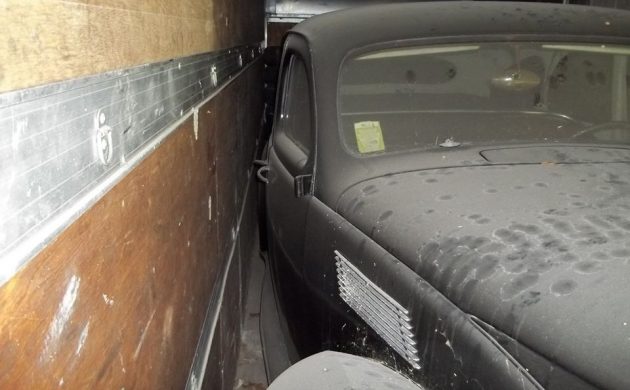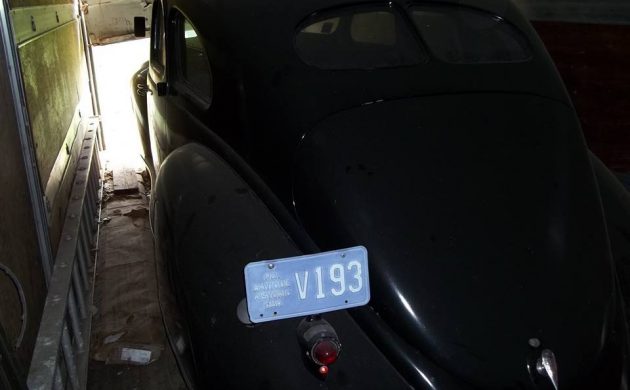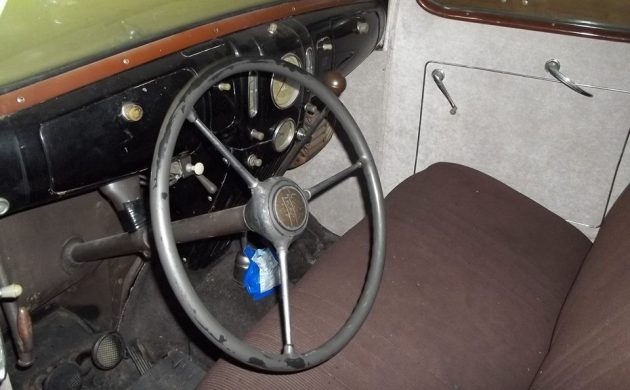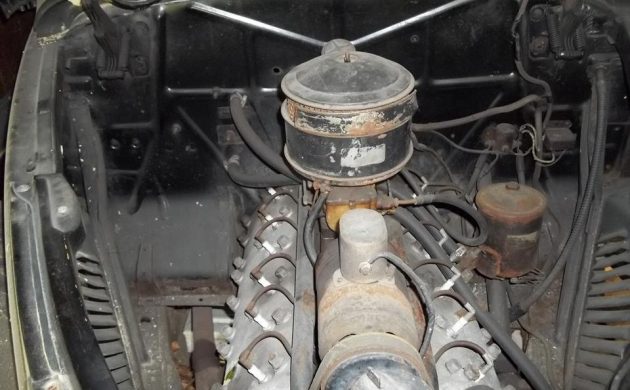When Henry Ford purchased the near-bankrupt Lincoln Motor Company in 1922, he did so for three very diverse reasons. One of these reasons was purely personal, as Lincoln founders, Henry M. Leland, had led a group of investors who forced Ford out of his own company (Henry Ford Company) in 1902. Ford was also keen to get his hands on some of the more advanced engineering innovations which Lincoln had brought to its own vehicles. The acquisition of Lincoln also gave Ford a brand that could compete with the likes of Cadillac, Duesenberg, and Packard. The illustrious Mr. Ford had no interest in running the company, so installed his son, Edsel, to undertake this role. Edsel flourished in the position and was able to release his pent-up styling flair and sense of good taste. One of the results of this effort was the Lincoln Zephyr, a car that Edsel saw through to fruition from a design by Eugene Turenne Gregorie. This 1937 Lincoln Zephyr, which is from the second year of production, was referred to us by Barn Finder James B, so thank you so much for that James. If it is a car that you would like to own, you will find it located in St. Thomas, Pennsylvania, and listed for sale here on Facebook. The owner is asking $11,500 for this classic Lincoln.
The styling of the Zephyr is as elegant as people came to expect from anything that was associated with Edsel Ford. He was known for his style and good taste, and he brought these strengths to the Lincoln name. This particular Zephyr has been in storage for around 30-years and has accumulated a fair coating of dust in that time. Looking under the dust reveals a car that looks like it is in quite good condition. The paint appears to be consistent, and there are no obvious signs of any dents or dings. As I sit writing this article, all that I want to do is to get the car out of the shed and give it a wash. I’d also like to check it to ensure that there are no rust issues. The car really does look like it would respond quite nicely to a good wash and polish.
The interior of the Zephyr doesn’t look to be too bad, but there are a few items to be attended to. The wheel looks like it needs to be restored, as there is some noticeable wear on it. The dash is also complete, but the paintwork on it needs to be restored. The upholstery appears to be original and in good all-round condition. The exception is the covers on the seats, which I believe are replacements. The material doesn’t appear to be of the type that was used by Lincoln during this era, so would need to be replaced to return the interior to the correct appearance.
When this Lincoln was parked some 30-years ago, it was still a running, driving vehicle. There is no word on the mechanical state of the car, so hopefully, the engine isn’t locked. What you get is an amazing 267ci V12 engine, which is backed by a 3-speed manual transmission. For all of those cylinders, the engine only produced 110hp, but this was still considered to be adequate power for what was a luxury car. It was engineering innovations such as those that went into this engine that was part of the catalyst for the buyout of Lincoln by Ford. The Lincoln V12 featured aluminum-alloy cylinder heads, a unique cooling system that utilizes two water pumps, and an ignition system the utilizes an ignition coil for each separate bank of 6-cylinders. Many of these engineering ideas had been in the works when Lincoln was going bankrupt, but it needed Ford money to bring the ideas to fruition. Given all of the complex engineering involved in that engine, hopefully, getting this Zephyr running again won’t be too difficult.
The Lincoln Zephyr was designed to be the entry-level vehicle that would bring customers into Lincoln’s mid-sized vehicle range. As an entry-level vehicle, it contained a lot of advanced engineering, along with some ground-breaking design features. It is often overlooked, but it is one of the most significant cars in the Lincoln range. At its peak, it accounted for around 80% of all Lincoln sales. This helped to put the company on a sound financial footing. It also makes it an important piece of the history of the Ford Motor Company, and worthy of being returned to active service.







Not that familiar with the presentation so couldn’t see all the pictures but what I could I like. What’s not to like about a V12 Zephyr? This one needs to be returned to the road where it belongs.
This post is even better than the original story. Cool memories.
This is the car (one like it) that got me
into the hobby. It eas the fall of ’66, and
I had just turned 12, and the biggest kick
I got in life then was hangin’ out with Dad
and his buddies–all of whom owned an
old car of some sort. The car I helped
Dad and his friends repair belonged to
Harry Heinz, a fellow police officer Dad
worked with at the time. Harry owned the car for years and drove it daily–until the
V-12 started giving him fits. The only
option was to rebuild the original engine
and hope for the best. My job was to
strip and clean the parts as they were
taken off it. Long story short, I moved
up from parts cleaner to actually installing the heads when the time came.
Along with the heads, I also mounted the
distributors and ran the wiring from them
to the coils and on to the plugs. Quite a
job for a 12 year old kid! And boy, was I
proud when that engine fired ip and ran
like a watch! That’s how I got into this
wonderful thing called the old car hobby.
Owned a lot of cars since then, but this
is the car that started it all.
My father inlaw had a 39′. He told me once that nobody could ever get that 12 cylinder running smoothly. And that was why he sold it after owning a year and a half. And looking at the photos, this car appears to have only two doors. I thought “sedan” was for four doors and hardtop, and “coupe” was a two door hardtop? It looks like a very nice car though.
FIL was right. I’ve known several that had flathead Mercs installed after pulling that V12 out. Ran a lot better.
This is the sedan and not the sought after coupe, but these cars still have a strong following.
Kenneth,
Wonderful story, thanks. Mine is much more humble. My dad got tired of me taking the lawnmower apart instead of cutting the grass and brought home a footlocker full of single banger lawnmower and wizzer motors. I promptly mounted everything on wheels I could find.
It would be nice to see this car after a washing and polishing.
Can’t understand why ALL sellers don’t provide an “after” picture. It’s not like they are going to leave the dust on forever.
Fred W — Say Amen Somebody! The romantic dusty crusty BF shtick is all fine and well, but after showing us a few pics of where a car has been sitting for 30 yrs, then take it out into light, clean it and shoot proper photos. Ridiculous to post photos where the only thing you can see is the license plate and crack of outside light. A black car inside a darkened trailer with no light… and you want buyer to pay $12,000. based on pics. This routine got old a long time ago.
Just curious, is the low displacement V12 any kin to the V60 ? I have no frame of reference here but thought I’d throw it out to a more knowledgeable follower…
Re: any relation between the V8/60 and the Zephyr V12. I guess that depends on the definition of “kin”.
The two engines do not share any parts that I know of, but both were “monoblock” castings for the cylinder block which was perfected with the original 221 Flathead V8 introduced for the 32 Fords. Technically Ford wasn’t the first with a monoblock V8, Oakland offered a V8 for just a few months prior to their demise, but total production was only a few thousand. Ford was first with large volume mass production of a V8 using a one piece block casting. Previously V engines were built up from a separate crankcase with separate cylinder blocks bolted to them. Both of the V-8’s, the 221 and the 136 cubic inch “v-8 60” spaced the two banks 90 degrees apart, typical for the vast majority of V8’s. The Lincoln V-12 has a 75 degree bank angle as opposed to the typical 60 degrees for V-12’s. The angle of 75 degrees splits the difference between 60 and 90.
The V8 60 was developed for Europe but the depression kept sales low over there and so it became an economy engine in the U.S. Interestingly the first few thousand of them made in Europe had 4 main bearings rather than the 3 of a typical flathead Ford. That design didn’t last long. The Speedway museum in Lincoln Nebraska has one on display.
One thing all three engines have in common is the way the exhaust ports have to make a torturous path from the top of the block around to the exhaust port exits on the lower outsides of each bank. That made for a rather complicated casting and it means that the Lincoln V-12 in the Zephyr, in view of it being a side valve engine is the most complicated block casting of any production car ever made.
Somebody should have helped the people with rough running V12s. Tuned properly that is one of the smoothest running engines you will ever see. In the old days the name sedan had nothing to do with number of doors.
I consider my BMW 2002 to be a (2-door) sport sedan. Their coupe was a much prettier 2-door. Same with later 3 series cars. But for the e36 I will concede to the term coupe.
Sedans came in two and four door versions – they shared the same roof line and differed only by the number of doors.
In the 1920’s and 1930’s two door sedans were called “coach” by many manufacturers, although Ford called theirs a “tudor” sedan.
Coupes had a smaller passenger compartment and in many cases a different roof line than the sedans. They were usually a little more sporty looking, which is how all two door sedans got the name “coupe” in the 1970’s when sportiness replaced comfort for back seat passengers in the two door models.
A friend of mine in South Africa has a very rare RHD model of this 1937 Lincoln Zephyr coupe. Unfortunately a previous owner had painted it metallic green! Looks fabulous but obviously very wrong. He also owns a 1939? coupe in RHD painted grey. (Pictured)
Ken Tilly,
Back about 1987 I was in London looking at some vintage cars a local dealer had for sale. One of those was a 1937 Zephyr coupe in Metallic green, and yes, it was also RHD. I wonder if it’s the same car? I may have a photo of it somewhere.
@Bill McCoskey.
I don’t think it is the same car but who knows? According to my friend he is of the opinion that there are only 7 RHD cars left. I don’t know when he acquired the green car but I sold him the grey car in 2002 when I was a dealer in classic cars and bikes.
That Zephyr dash, along with many styling cues like the sharp edges along the tops of the fenders and the flow of the trunk into the bumpers, must have blown people away at the time. VERY ahead of its time. The dash design was a precursor to every car with a console that came after. Agree that the seller would getting his ask if he could simply roll the car out of the wooden box it’s stored in. Sheesh.
My Dad’s first serious venture in The Classic Car Club was a ’37 Packard Town Car. It was originally owned by North Western Bell, the phone company. It was the limo, and was the presidents of the company , at the time, personal company vehicle. My Dad was the second owner. It sat for many years on a property owned by NWB. It had the parade jump seats with a ramp to accommodate moving the seats out to the polo grounds / parade, or whatever the social function was. It wasn’t a real high point car per desirability, but it was the cats ass back in the late 60’s.
My great grandfather bought a new Lincoln Zephyr for my grandmother in 1937 and family photos indicate that it looked quite similar to this one. I recently found the Service Policy from that car (bought from Schildkraut Motor Sales, Inc on April 21, 1937) and it had the engine number: H30333. I wonder how far this one might be from my great grandmother’s car.
The cover of the Service Policy.